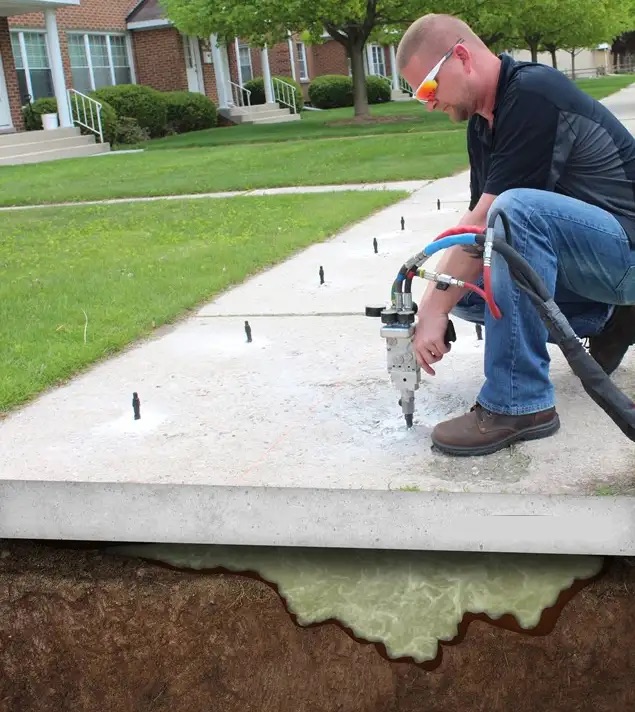Concrete is a staple in modern construction. From driveways to sidewalks to patios, it’s the material of choice for creating durable, long-lasting surfaces. But over time, even the strongest concrete can shift, sink, or settle. This can lead to uneven surfaces, safety hazards, and compromised aesthetics. Fortunately, concrete lifting offers a solution that is both efficient and cost-effective. Let’s delve into the world of concrete lifting to understand how it works, why it’s essential, and what benefits it brings.
What Is Concrete Lifting?
Concrete lifting, also known as slab jacking, mudjacking, or polyjacking, is a technique used to raise sunken or uneven concrete surfaces back to their original level. The process involves injecting a lifting material underneath the concrete slab to push it back into place.
Concrete lifting is commonly used to repair sidewalks, driveways, patios, pool decks, and even foundation slabs. It’s a versatile method that can save homeowners and businesses from the expense and inconvenience of completely replacing concrete surfaces.
Why Does Concrete Sink?
To understand the need for concrete lifting, it’s essential to know why concrete sinks in the first place. There are several reasons why this happens:
- Soil Settlement: Over time, the soil beneath a concrete slab can compact or shift, causing the concrete to sink. This is often due to poor soil preparation during construction or natural changes in the soil composition.
- Erosion: Water erosion from heavy rain, flooding, or improper drainage can wash away the soil beneath a concrete slab, leading to instability and sinking.
- Tree Roots: As trees grow, their roots can push against concrete slabs, causing them to lift or crack. When the roots die or are removed, the soil can settle, causing the slab to sink.
- Heavy Loads: Continuous heavy loads on concrete surfaces, such as parked vehicles or construction equipment, can compress the soil, leading to settling.
The Concrete Lifting Process
Concrete lifting is a multi-step process that requires precision and expertise. While the exact method can vary depending on the technique used (mudjacking, polyjacking, or other), the general steps are as follows:
- Assessment: A professional assesses the extent of the sinking and identifies the cause. This step is crucial in determining the best lifting method and ensuring a successful repair.
- Drilling Holes: Small holes (typically around 1-2 inches in diameter) are drilled into the concrete slab at strategic locations. These holes will be used to inject the lifting material.
- Injection of Lifting Material: Depending on the method used, a specific material is injected into the holes. In mudjacking, a slurry of cement, soil, and water is used. In polyjacking, a high-density polyurethane foam is injected. As the material is injected, it expands, filling voids and raising the concrete slab to the desired level.
- Leveling and Sealing: Once the slab is raised, it is leveled to ensure a smooth surface. The holes are then sealed with a concrete patching material, leaving a clean and finished appearance.
- Cleanup: The work area is cleaned, and any debris or excess materials are removed.
Benefits of Concrete Lifting
Concrete lifting offers several advantages over traditional concrete replacement. Here are some key benefits:
- Cost-Effective: Concrete lifting is typically much less expensive than completely replacing a concrete slab. It uses fewer materials and requires less labor, resulting in significant cost savings.
- Time-Efficient: Concrete lifting is a quick process, often completed in a matter of hours. This means less disruption to your daily life or business operations compared to the lengthy process of removing and replacing concrete.
- Environmentally Friendly: Concrete lifting reduces waste by reusing existing concrete slabs, reducing the need for new materials. This makes it a more sustainable option.
- Minimally Invasive: Because concrete lifting uses small holes to inject the lifting material, it is less disruptive to the surrounding area. There is no need to demolish or remove large sections of concrete, reducing the mess and noise.
- Durable and Long-Lasting: When done correctly, concrete lifting can provide a long-lasting solution. The lifting material, especially polyurethane foam, is resistant to water and erosion, ensuring that the repaired surface remains stable for years.
Choosing the Right Professional for Concrete Lifting
If you’re considering concrete lifting, it’s essential to choose a reputable professional with experience in the field. Look for contractors who specialize in concrete repair and have a track record of successful projects. Check for licenses, certifications, and insurance to ensure you’re working with a qualified professional.
Additionally, ask for references or read reviews from previous clients to get a sense of the quality of work you can expect. A reliable contractor will provide a detailed estimate, explain the process, and answer any questions you have.
Conclusion
Concrete lifting is a powerful solution for addressing sunken or uneven concrete surfaces. Whether it’s a driveway, sidewalk, or patio, this technique can restore stability and aesthetics without the high cost and inconvenience of complete replacement. By understanding the process and its benefits, you can make an informed decision about whether concrete lifting is right for your needs. If you do decide to proceed, be sure to choose a reputable professional to ensure a successful and long-lasting repair.









